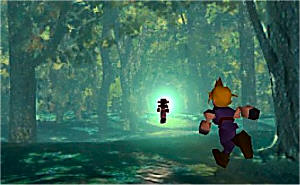
Cloud and Aerith’s Love
Remember that symbolism is highly used in Japanese anime and magna, as well as in Japanese fiction. Non-verbal symbolism and imagery is a very important part of anime, manga, and video games produced in Japan. The artists will often choose to use a certain color, item, animal, or event based on its symbolic meaning within Japanese culture. Many of these themes, elements, and symbolisms are related to each other in how they are used and what they mean.

The first symbol that we see of Cloud and Aerith’s love for one another is that she wears a ribbon in her hair. As in many Asian cultures, Japanese folklore says that future lovers are connected at birth by a red ribbon, and that lovers are destined to be with one another. This ribbon, of course, is invisible to humans, but spirits and gods can observe the interconnections between fated pairs. Any match ups between two people not connected by the ribbon are destined to fail. A euphemism for "to break up" is "ito wo kiru", meaning "to cut the thread".
Japanese Culture: Moons, Ribbons, and Sneezes
The Sailor Moon Miscellany FAQ
Kasumi No Daidokoro (Kasumi's Kitchen)
Some Westerners may object that Aerith is wearing a pink ribbon, not a red one. The Japanese, in contrast with Westerners, grasp colors on an intuitively horizontal plane, and pay little heed to the influences of light. Colors, whether intense or soft, are identified not so much on the basis of reflected light or shadow, but in terms of the meaning or feeling associated with them. As a result, pink is actually considered a shade of red in Japan.
For further information on this, see: Japanese Conception of the Color Red: Is Red the Color of Love?, then click on Traditional Shades of Red (in Japan).

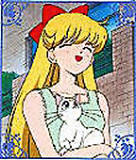
A red ribbon of this sort as shown on the senshi of love in a Sailormoon anime.
The tradition of a red ribbon symbolizing predestined love in a couple continues further in the belief that individuals who have found true love are actually connected by a ribbon, string, or thread. True loves are soulmates who have been tied together by a red ribbon of fate. This connection of true love enables the couple to know when one of them is in trouble and to even hear their voice. This kind of symbolism is shown in Japanese anime quite often.
The Anime Primer: Japanese Culture in Anime
This connection of true love is actually enacted between Cloud and Aerith shortly before her death. First we see Cloud wake up in the middle of the night knowing that Aerith is in danger, and then Cloud hears Aerith’s voice coming from a distant building in the Forgotten City. Here is that excerpt from the script:
 (They
all rest for the night. The scene shifts to later that night. Cloud is awake,
and standing
(They
all rest for the night. The scene shifts to later that night. Cloud is awake,
and standing
away from the others. He looks up.)
Cloud "I feel it..."
(The others come in. Cloud must have woken them up.)
Cid "Do you know what TIME it is!?"
(Cloud turns to them.)
Cloud "Aerith is here.
...and so is Sephiroth."
Cid "Wa, wa, wait a minute. You serious!?"
Tifa "But how can you tell?"
Cloud "...It's not an excuse. I feel it in my soul."
Cid "Shit, Cloud, we can't be sittin' around on our asses."
 Cloud
"...right. Let's hurry and find Aerith."
Cloud
"...right. Let's hurry and find Aerith."
(They leave the house.)
(Reaching the intersection near the entrance of the Forgotten City, Cloud looks to the north.)
Cloud "Aerith's voice...... Coming from there?"
(He rushes north. Passing through a tunnel, he reaches a secluded, calm, mirrorlike pool. Sunlight shines from above, though it is still midnight. He continues. He enters a small, spiral-shaped building. Taking a long, glass stairway there, he reaches a huge, elegant, crystalline city, suspended in space. Continuing on, he finds a small shrine. Aerith is kneeling inside it.)
Cloud
"Aerith?"
RPGamer: Final Fantasy VII Complete Script
Cloud and Aerith are shown in the above scene as having the connection of the ribbon, or string, which demonstrates that true love exists between them as represented in the folklore of Japan. By virtue of this connection, Cloud awakens in the middle of the night knowing that Aerith is in danger from Sephiroth, and Cloud is able to hear Aerith’s voice coming from a distant building in the Forgotten City.
Not only does Aerith wear a red ribbon, which is symbolic of predestined love to the Japanese, but a connection of true love in the Japanese tradition is seen to exist between Cloud and Aerith. Japanese and Asian folklore says that individuals who have found true love are connected by a string, ribbon, or thread which enables the couple to know when one of them is in trouble as well as to hear their voice at a distance. The Anime Primer: Japanese Culture in Anime Squaresoft actually enacted this symbolism of the ribbon in the scene above, which means that true love exists between Cloud and Aerith. This same connection of true love would also explain how Cloud and Aerith were able to communicate with one another in the Sleeping Forest scene when Aerith leaves for the Forgotten City.

(The scene fades in... a calm green forest. Aerith pokes her head around one tree.)
Aerith "Cloud, can you hear me?"
(Cloud speaks, though he does not appear on screen.)
Cloud "Yeah, I hear you. Sorry for what happened."
Again, we see the connection of true love in the Japanese tradition occurring between Cloud and Aerith, since he is able to hear her and communicate with her even though she is not physically present. Once again, the symbolism of a red thread of predestined love is enacted by Squaresoft to show a connection of true love existing between Cloud and Aerith.
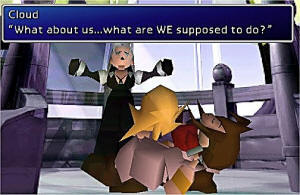
Then Aerith is taken from Cloud by a cruel act of Fate at the hands of Sephiroth. Although Aerith’s ribbon, the symbol of their love, is seen falling from her hair in the FMV of her death, it actually remains on her, as you can see in the picture above. Aerith is still wearing her ribbon when seen in her final picture at the end of the game, as well. This can only mean that, although Aerith has been separated from Cloud in life, the connection of their love continues after her death.
Related to this idea of a ribbon connecting two lovers is the corresponding idea that a relationship between two people not connected by a ribbon is destined to fail. Since Tifa wears no ribbon, then a love relationship between she and Cloud would be destined to fail.
Japanese Culture: Moons, Ribbons, and Sneezes
The Sailor Moon Miscellany FAQ
In the final FMV, we do indeed see a potential relationship between Cloud and Tifa fail when he says, “I think I can meet her… there”, meaning that Cloud wants to go to Aerith. From Tifa’s initial reaction to Cloud’s words, it’s clear she realizes that Cloud wants to be with Aerith, and that Aerith will always be first in his heart.
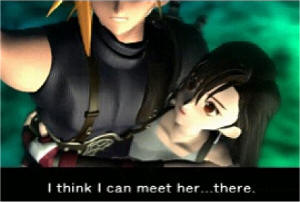
One of Aerith’s weapons is an umbrella, which also has cultural significance to the Japanese. Aiai-gasa, translated as "Two under the same umbrella", is associated with couples in love. A simple sketch like the one below, showing the names of the pair, means "Moriyoshi and Noriko like each other." Why would one of Aerith's weapons be an umbrella, of all things, except to signify this?
Japanese Culture and Daily Life


from Japanese Culture and Daily Life
Remember, too, that flowers and flower blossoms are traditionally associated
with femininity and womanhood, and are often used within anime and manga to
represent love, a girl blooming into womanhood, a girl opening up to the world
around her, and other images of this sort. As a flower girl, Aerith is the
embodiment of this imagery.
 The
colors that Aerith and Tifa wear are also culturally significant to the
Japanese. Aerith wears different shades of red. (Remember that pink is actually
considered a shade of red to the Japanese). There is a word in Japanese, “ko
itten”, which means "touch of scarlet." The phrase is used as an affectionate
term for women, especially Geisha girls. The use of the color red in dress and
makeup is very significant to Japanese society. Red
is denoted as a color of beauty and happiness. Red is
also thought to be erotic to men. It is considered to be
a sensual color, and can be associated with man's
most profound urges and impulses.
The
colors that Aerith and Tifa wear are also culturally significant to the
Japanese. Aerith wears different shades of red. (Remember that pink is actually
considered a shade of red to the Japanese). There is a word in Japanese, “ko
itten”, which means "touch of scarlet." The phrase is used as an affectionate
term for women, especially Geisha girls. The use of the color red in dress and
makeup is very significant to Japanese society. Red
is denoted as a color of beauty and happiness. Red is
also thought to be erotic to men. It is considered to be
a sensual color, and can be associated with man's
most profound urges and impulses.
 Compare
this to Tifa, who wears different shades of black, since gray would be
considered a shade of black in Japan. To the Japanese, black can stand for
mourning as well as for cheerless occasions. For example,
traditional garb for a funeral is black and white,
with black representing the loss. When used by itself, black can represent bad
luck or misfortune.
Compare
this to Tifa, who wears different shades of black, since gray would be
considered a shade of black in Japan. To the Japanese, black can stand for
mourning as well as for cheerless occasions. For example,
traditional garb for a funeral is black and white,
with black representing the loss. When used by itself, black can represent bad
luck or misfortune.
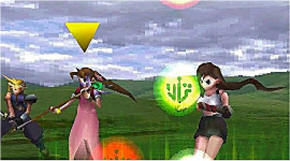
Why Symbolism?
We’ve seen that the cultural differences between Japanese and Western society have influenced the portrayal of Cloud’s love for Aerith, and that their love was shown symbolically in a manner drawn from Japanese tradition. The portrayal of love relationships by Squaresoft became more Westernized in subsequent games, perhaps due to the confusion demonstrated by Western audiences over the Love Triangle in Final Fantasy VII. From comments made by the director of the Final Fantasy cast in Kingdom Hearts, we can see that Squaresoft was very aware of the confusion in the Western audience generated by their use of symbolism to portray Cloud and Aerith’s love. There is, however, a second factor, besides cultural differences, that would have contributed to a decision by Squaresoft to show Cloud and Aerith’s love symbolically rather than by overt expression of it within the game before Aerith’s death.
There is a “mini-game” included during the play of Disk One which allows Cloud to go on a date at the Gold Saucer with Aerith, Yuffie, Tifa, or Barrett, depending on choices made in dialogue by the player. An overt expression of love occurring between Cloud and Aerith prior to her death would have conflicted with the believability of this “mini-game” should the player choose to date a character other than Aerith. Therefore, using symbolism to represent Cloud and Aerith’s love for one another allows the Date “mini-game” to play through for characters other than Aerith without overt contradiction. It must be remembered, though, that the default character for Cloud to go on a date with in this “mini-game” is Aerith.

It makes sense that Squaresoft would include the Date “mini-game” for the purpose of replay value for Final Fantasy VII. Once the game has been played through in its entirety and the player learns of Aerith’s death, the Date “mini-game” allows for variation and added enjoyment while re-playing Disk One.
One thing that often confuses the Western audience is that there are no scenes in Disk Two where Cloud is shown to mourn the loss of Aerith. Some Westerners take this as an indication that Aerith didn’t actually mean that much to Cloud. This is another thing which can be explained when you understand the behavior of mourning in Japan.
In Japan, healthy grief consists of talking about the loss of a loved one only occasionally with one or two close female relatives. If friends come to pay a visit soon after a death, it is expected that the friends will be entertained. The subject of how the bereaved is faring is quickly dismissed by saying something like, "Oh, I'm fine and how is your son doing in college?"
Grief, Mourning, and Funeral Traditions

In Japan, it is considered important not to show one's grief after the death of a loved one for a number of reasons - death should be seen as a time of liberation and not sorrow, one should bear up under misfortune with strength and acceptance, one never does anything to make someone else uncomfortable (including cry), and if there is a problem it should be handled within the family - to talk with outsiders indicates that the family is not strong enough to take care of it.
Grief, Mourning, and Funeral Traditions
Here are some notes from a young Japanese-American explaining how grief is traditionally shown at a Japanese funeral, in reference to her grandfather Toshi's death:
Karen spoke about the proper amount of grief that should be shown by close family members at the funeral services - discrete weeping with a smile breaking through is good, sobbing is never acceptable and she actually remembers attending a funeral where the sobbing widow was secretly ridiculed by the guests. Clearly, Karen feels that her mother-in-law would define unhealthy grief as someone who "goes on and on about it" and complains about her fate even to close relatives.
The ceremony at the grave was similar to the one at the funeral chapel. In both events there was a focus on the person moving on to another world where he could be of help to those still living. He was given a new name in death and it was understood that he was now perfect, had joined the other ancestors and had achieved the rank almost of a semi-god. He could receive prayers and be of great assistance to the living. Clearly these were beliefs that could offer great comfort to the bereaved. Grief, Mourning, and Funeral Traditions
Sacrifice
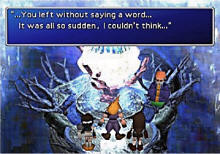 Sacrifice is another theme occurring in Final Fantasy VII as well as in Japanese
anime and magna. In the karmic balance of the world, nothing is gained without
something else being lost, according to the Japanese. Shoujo and
bishoujo stories often have the element of sacrifice included to express to
the audience ideas such as true friendship or true love. A sacrifice could be
something as extreme as death, or giving up on your own hopes and dreams, so
someone else can accomplish theirs. One character's sacrifice for someone else
empowers the other character, and cements in
the minds of the audience just how much the
character who made the sacrifice means.
Sacrifice is another theme occurring in Final Fantasy VII as well as in Japanese
anime and magna. In the karmic balance of the world, nothing is gained without
something else being lost, according to the Japanese. Shoujo and
bishoujo stories often have the element of sacrifice included to express to
the audience ideas such as true friendship or true love. A sacrifice could be
something as extreme as death, or giving up on your own hopes and dreams, so
someone else can accomplish theirs. One character's sacrifice for someone else
empowers the other character, and cements in
the minds of the audience just how much the
character who made the sacrifice means.
Symbolism in Anime: Love and Friendship
Of course, Aerith made the ultimate sacrifice of giving her life for the sake of the Planet, and she remains cemented in the minds of all who play Final Fantasy VII, as well as in the mind of Cloud and the others.
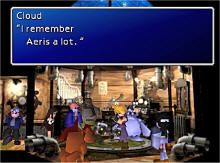 In
Bugenhagen’s laboratory after Aerith’s death:
In
Bugenhagen’s laboratory after Aerith’s death:
Bugenhagen "Do you see it? What is it that you are searching for?"
(The scene fades back in; we are at Bugenhagen's observatory, now, the entire party is present...)
Cait Sith "Nope. Not a thing. Naw. Can't come up with a thing."
(Cloud looks down)
Cloud "I remember Aerith a lot."
"No... not that. You haven't remembered. You haven't forgotten. That's not it... How would you say it... Aerith was right there all along. Right by our side. She was so close, we couldn't see her. What Aerith did... The words she left behind..."
Tifa "That reminds me... I was the same."
Red XIII "As was I."
Barret "Me too..."
RPGamer: Final Fantasy VII Complete Script
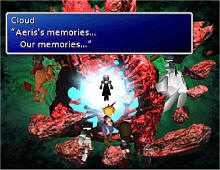 Aerith’s sacrifice empowers Cloud and the others to accomplish their mission to
save the Planet and defeat Sephiroth. It is arguable whether Aerith actually had
a premonition that she would have to make this sacrifice. After all, Aerith
tells Cloud in the Sleeping Forest, “I’ll be back when it’s all over”, which
indicates that she did intend to return to him.
Aerith’s sacrifice empowers Cloud and the others to accomplish their mission to
save the Planet and defeat Sephiroth. It is arguable whether Aerith actually had
a premonition that she would have to make this sacrifice. After all, Aerith
tells Cloud in the Sleeping Forest, “I’ll be back when it’s all over”, which
indicates that she did intend to return to him.
Or perhaps she did return?
![]()
~ The Love Triangle of Final Fantasy VII is further discussed at Destiny Fulfilled: Cloud and Aerith's Love